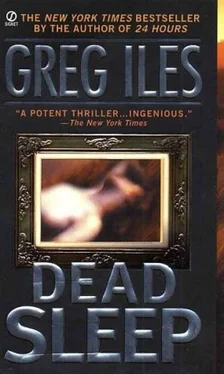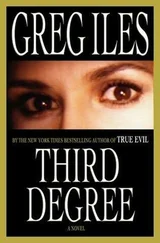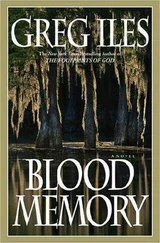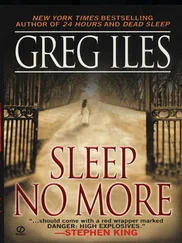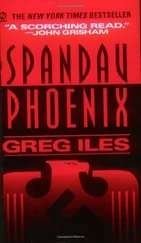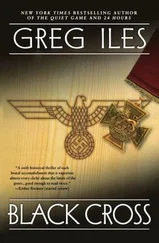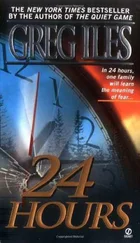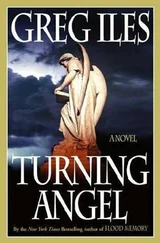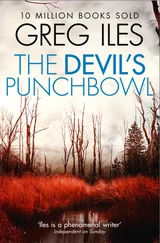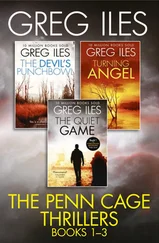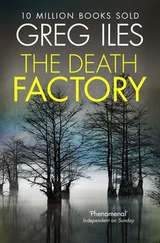“What the hell?” says Kaiser.
“It’s the painting,” says Lenz. “Keep going. There, to your right.”
Baxter says, “We want to get you in there pretty quickly, Jordan. Before Wheaton gets too comfortable.”
“Are you Roger Wheaton?” asks Kaiser.
There’s a pause, then a man with a deep, avuncular voice says, “Yes. Are you the gentlemen from the FBI?”
“I’m Special Agent Kaiser. This is Doctor Arthur Lenz. Doctor Lenz is a forensic psychiatrist.”
“How curious. Well, good day to you both. How can I help you?”
“We have some questions for you, Mr. Wheaton. They shouldn’t take too long.”
“Good. I like to get the paint on quickly.”
“This painting is… stupendous,” says Lenz, his voice filled with awe. “It’s your masterpiece.”
“I hope so,” Wheaton replies. “It’s my last.”
“The last Clearing, you mean?”
“Yes.”
“It’s a monument to your entire body of work.”
“Thank you.”
“But why stop now?”
There’s another pause, and when Wheaton answers, his voice is heavy with regret. “My health isn’t what it once was. It’s time for a new direction, I think. You have some questions, the president said? It all sounded very mysterious.”
“Mr. Wheaton,” says Kaiser, “over the past year, eleven women have disappeared from the New Orleans area without trace. Are you aware of that?”
“How could I not be? There are safety-awareness meetings twice a week for the female students here. Flyers on every wall.”
“That’s good. We’re here about those disappearances. You see, several of the victims have turned up, in a manner of speaking.”
“I read that the woman taken from the grocery store was found. But the paper said the FBI doesn’t think she was taken by the same man.”
Kaiser’s voice takes on a tone of confidence. “The media has its uses. I’m sure you understand.”
After a pause, Wheaton says, “I see. Well. You said several of the victims have turned up. You’ve discovered more bodies?”
“Not exactly. We’ve discovered a series of paintings that depicts these women.”
“Paintings? Paintings of the missing women?”
“Correct. In these paintings, the women are nude, and posed in positions of sleep. Possibly in death.”
“My God. And you’ve come to ask me about this?”
“Yes.”
“Why? Were the paintings discovered nearby?”
“No. In a museum in Hong Kong.”
“Hong Kong? I don’t understand.”
I touch Baxter’s arm. “I thought Dr. Lenz was going to take the lead on the questions.”
“Arthur wanted it this way. He wants John to ask the questions that have to be asked. He’ll jump in when he’s ready. Arthur’s a subtle guy.”
“Mr. Wheaton,” says Kaiser, “in examining these paintings forensically, we’ve recovered some hairs from them. The hairs come from a special type of paintbrush. Kolinsky sable.”
“You’re investigating every artist in America who uses Kolinsky sable brushes?”
“No, that would be too big a job, even for us. But these weren’t ordinary Kolinsky sable. They’re a very fine grade – the finest, actually – produced by one small factory in Manchuria. There’s only one U.S. importer, and he sells a very limited quantity. To select customers.”
“And Tulane University was one of those customers. Now I see. Of course. I placed that order. For obvious reasons, I hope.”
“Could you tell us why, obvious as it may be?”
“They’re the finest brushes in the world. Highly resilient. They’re generally used for watercolor, but they’re adaptable to any medium. I use them for fine work in my oils.”
“Your students use them as well?”
“Had I not ordered them for this program, two of my students wouldn’t be able to afford such tools. That’s one of the benefits of an academic setting.”
“That would be Ms. Laveau and Mr. Gaines?”
Wheaton chuckles. “Yes. Frank could buy a Manchurian sable ranch if he chose to.”
“You’re referring to Mr. Smith?” asks Kaiser.
“Yes. Frank Smith.”
“Is that a Kolinsky brush you’re using now?”
“No, this is hog bristle. Crude-sounding, isn’t it? But a fine brush all the same.”
“Have you always used the rare Kolinsky brushes?”
“No.” This time the pause seems interminable. “Three years ago I was diagnosed with an autoimmune disease that affects my hands and fingers. I’ve had to alter the mechanics of my brush stroke to remain consistent with my own style. I experimented for a while, and finally discovered the special Kolinskys. They worked so well that I encouraged my students to try them.”
“I see. How many people have access to these brushes?”
“My graduate students, of course.”
“Anyone else?”
“Well… this isn’t a high-security area, as you can see. Anyone could walk in here and take one if they really wanted to. Undergraduates frequently come through to see my work in progress. We’d have to have twenty-four-hour guards to keep them out.”
“Mr. Wheaton,” Kaiser says in an apologetic tone, “I hesitate to ask this, but would you have any trouble providing alibis for a group of dates over the past eighteen months?”
“I’d have to see the dates. Are you saying I’m a suspect in these terrible crimes?”
“Anyone with access to these brushes is by definition a suspect. Do you know where you were three nights ago, after the opening at the museum? Say from eight forty-five to nine-fifteen?”
“I was at home. And I foresee your next question. I was alone, as it happens. Should I contact an attorney?”
“That’s your prerogative, sir. I wouldn’t want to influence you either way.”
“I see.” Wheaton is answering more slowly now, his words preceded by careful thought.
“Would you mind telling us how you selected each of your students?” asks Kaiser.
“I suppose not. Each applicant submitted paintings for review. There were quite a lot to go through. I initially looked at photos sent through the mail. Then I flew down and examined a group of paintings by each of the finalists.”
“Did you use any criteria other than the applicants’ paintings?”
“None.”
“Did you have biographical information on the applicants?”
“I believe I had a brief sheet on each one. A CV of sorts, though with artists that’s not a very formal document. Leon Gaines’s resume made interesting reading.”
“I imagine it did.” Kaiser is trying to sound friendly, but there’s no hiding the fact that this is an interrogation. “What was it about the work of each that impressed you?”
“I don’t think I can give you a short answer to that,” Wheaton replies.
“Could you give us a verbal sketch of each student?”
“I really don’t know that much about them.”
“Frank Smith, say.”
Another long silence, but whether it’s caused by reluctance to comply or by Wheaton searching for words is unknowable from the isolation of the van.
“I’m very fond of Frank,” Wheaton says finally. “He’s a talented boy. He’s never known financial hardship, but I think his childhood was difficult. He had one of those fathers, you know. Great expectations, of the conventional kind. Frank’s talent and dedication are unbounded, and he’s only going to get better. He’s meticulous in technique and fearless in dealing with his subject matter. I don’t know what else to say. I’m not a critic. And I’m certainly no detective.”
“Of course. Have you ever seen Frank Smith get violent?”
“ Violent? He’s passionate about his work. But violent? No. He hasn’t much respect for other artists’ work, I can tell you that. He rubs a lot of people the wrong way. Frank knows just about everything there is to know about art history, and he doesn’t suffer fools gladly. You can imagine how that affects a man like Leon Gaines.”
Читать дальше
Конец ознакомительного отрывка
Купить книгу
